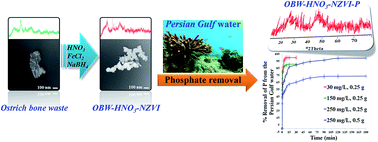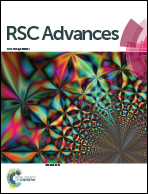Phosphate removal by a nano-biosorbent from the synthetic and real (Persian Gulf) water samples†
Abstract
The performance of ostrich bone waste-supported nanoscale zero valent iron (OBW-HNO3-NZVI) adsorbent for phosphate removal from the synthetic and real water samples has been evaluated, and the materials were studied by X-ray diffraction (XRD), surface area measurements (BET), transmission electron microscopy (TEM), chemical analysis (CHN), Fourier transform infrared (FTIR), inductively coupled plasma atomic emission spectroscopy (ICP-AES) and point of zero (pHPZC) techniques. Iran is the world's third largest breeder and producer of ostrich meat, after South Africa and China. The combination of ZVI particles on the surface of modified ostrich bone waste can help to overcome the disadvantage of ultra-fine powders, which may have strong tendency to agglomerate into larger particles, resulting in an adverse effect on both effective surface area and catalyst performance. Good dispersion of NZVI particles (ca. 5–45 nm) on the bone waste was observed. The contact time to attain equilibrium for maximum adsorption of phosphate (99%) was found to be 5 min. The adsorption kinetics of phosphate (P) has been evaluated in terms of pseudo-first-order and pseudo-second-order kinetics, and the Freundlich, Langmuir and Langmuir–Freundlich isotherm models have also been used to obtain the equilibrium adsorption results. The adsorption process was spontaneous and endothermic in nature and was followed a pseudo-second-order kinetic model. XRD analysis showed the appearance of Fe3(PO4)2·8H2O (vivianite) on the OBW-HNO3-NZVI surface after the adsorption of P from aqueous media. The immobilized NZVI indicated high reusability because of its high removal capacity after the 12th adsorption–desorption cycles. The developed adsorbent could also be used to remove the P ions from the real samples (Persian Gulf water). The high removal capacity of P ions from real water and the high levels of reusability confirmed the versatility of this nanobiomaterial supported on ostrich bone waste.


 Please wait while we load your content...
Please wait while we load your content...